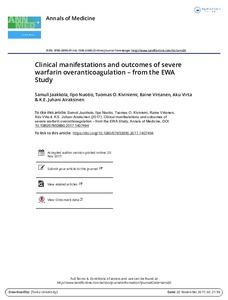Clinical manifestations and outcomes of severe warfarin overanticoagulation: from the EWA study
Jaakkola Samuli; Nuotio Ilpo; Kiviniemi Tuomas; Virtanen Raine; Virta Aku; Airaksinen K. E. Juhani
https://urn.fi/URN:NBN:fi-fe2021042718233
Tiivistelmä
Introduction: Severe warfarin overanticoagulation is a risk factor for bleeding, but there is little information on its manifestations, prognosis and factors affecting the outcome. We describe the manifestations and clinical outcomes of severe warfarin overanticoagulation in a large group of patients with atrial fibrillation (AF).
Material and methods: All international normalized ratio (INR) samples (n = 961,431) in the Turku University Hospital region between 2003 and 2015 were screened. A total of 412 AF patients with INR ≥9 were compared to 405 patients with stable warfarin anticoagulation for AF. Electronic patient records were manually reviewed to collect comprehensive data.
Results: Of the 412 patients with INR ≥9, bleeding was the primary manifestation in 105 (25.5%). Non-bleeding symptoms were recorded in 165 (40.0%) patients and 142 (34.5%) had no symptoms. A total of 17 (16.2%) patients with a bleed and 67 (21.8%) without bleeding died within 30 days after the event. Intracranial haemorrhage strongly predicted death within 30 days. Other significant predictors were non-bleeding symptoms, active malignancies, recent bleed, history of myocardial infarction, older age, renal dysfunction and a recent treatment episode.
Conclusions: Bleeds are not the major determinant of the poor prognosis in severe overanticoagulation, as coincidental INR ≥9 findings also associate with high mortality.
Kokoelmat
- Rinnakkaistallenteet [27094]
